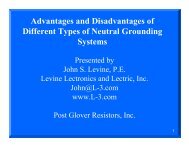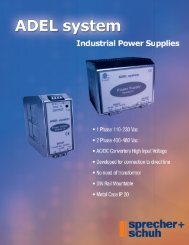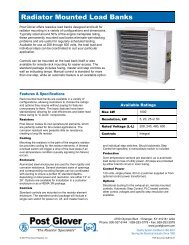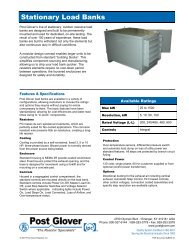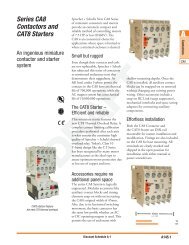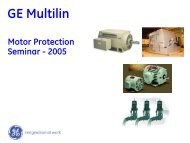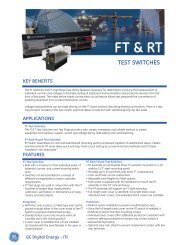IEEE Hybrid Grounding
IEEE Hybrid Grounding
IEEE Hybrid Grounding
Create successful ePaper yourself
Turn your PDF publications into a flip-book with our unique Google optimized e-Paper software.
of available fault current can cause relay coordination<br />
problems. Consideration should be given to selecting<br />
appropriate surge arresters for the grounding method.<br />
For a system with multiple sources, some of the variations in<br />
the low-resistance grounding method are discussed below.<br />
a) Single Point <strong>Grounding</strong><br />
Single point grounding requires that only one source be<br />
grounded at any given time. This is the simplest method of<br />
low-resistance grounding. Since there is only one ground<br />
source, it provides lower ground fault current than with<br />
multiple point grounding. Also, relay coordination is simple<br />
since there is no variation in ground current. In addition,<br />
third-harmonic circulating currents are eliminated.<br />
The principle disadvantage of single point grounding is<br />
that if the grounded power source is out of service, the<br />
system will operate ungrounded unless an alternate ground is<br />
established. This requires special operating procedures.<br />
<strong>Grounding</strong> the system neutral through a neutral deriving<br />
transformer on the bus is an effective means of overcoming<br />
this disadvantage.<br />
b) Multiple Point <strong>Grounding</strong><br />
In this method, the neutrals of individual sources<br />
(transformers and generators) are each grounded through a<br />
separate resistor with ground fault current from each source<br />
limited to the selected value. Multiple point grounding offers<br />
simplified operation and is most commonly used with lowresistance<br />
grounding, assuring that the system will always be<br />
grounded. However, resistor selection can be difficult.<br />
When several sources are paralleled, the total ground<br />
fault current can increase to high values, causing severe fault<br />
damage. In such cases, the grounding resistance should be<br />
high enough to limit the fault current to a safe value when all<br />
of the parallel sources are in service, and should be low<br />
enough so that when source(s) are removed, sufficient fault<br />
current flows for relay operation.<br />
Addition or removal of parallel sources causes wide<br />
variations in fault current and makes relay coordination<br />
difficult. Another problem is that the parallel paths to ground<br />
introduce the possibility of circulating third harmonic<br />
currents, which can cause overheating of the generators at<br />
less than full load.<br />
c) Common Ground with Neutral Switching (not<br />
Recommended):<br />
Here, each source is connected to a common neutral point<br />
through a switching device and the neutral point is grounded<br />
through the low resistance. The advantages include low<br />
ground fault current due to single ground, known maximum<br />
ground current, minimizing of the problems of varying<br />
ground current with addition or removal of generators, and<br />
simplified relay coordination. This is a previously adopted<br />
method but no longer being used due to safety issues as<br />
explained below.<br />
There are several disadvantages with this method of<br />
grounding. The most significant is a safety issue i.e.,<br />
attempting to switch the neutral at the same instant a ground<br />
fault occurs could be extremely hazardous to operating<br />
personnel, unless adequate switching devices and safety<br />
precautions are provided. Also, cost is increased due to the<br />
need for several neutral switches or circuit breakers. In<br />
addition, unless a key-interlock system is used, special<br />
operating procedures are required to close another operating<br />
ground point prior to taking the first one out. This may<br />
introduce operator errors causing ungrounded operation.<br />
All ground sources should be in close proximity in order<br />
to allow quick interchanging of neutral switching operations,<br />
to minimize conductor length of neutral bus connection for<br />
effective grounding, and to avoid inadvertent opening of<br />
interconnection thereby preventing ungrounded operation. If<br />
the neutral is left connected when a generator is taken out of<br />
service, all the phase voltages will be elevated in magnitude<br />
during a ground fault. Also, there is a possibility of<br />
accidental contact with an energized bus that leads to the<br />
ground bus.<br />
For these reasons, the practice of employing a common<br />
ground with neutral switching should be avoided.<br />
III. EFFECTIVELY GROUNDED SYSTEM<br />
For effectively grounded systems, the neutral is<br />
connected to ground through a sufficiently low impedance,<br />
intentionally inserted such that the ratio X 0 /X 1 is positive and<br />
less than 3, and the ratio R 0 /X 1 is positive and less than 1.<br />
These specific criteria are to limit the build-up of voltages in<br />
excess of limits established for apparatus, circuits, or systems<br />
so grounded. “Solidly grounded” systems have no impedance<br />
inserted intentionally between neutral and ground.<br />
Since the natural zero sequence impedance of a<br />
synchronous generator is typically about half the subtransient<br />
positive sequence reactance, the ground fault current that<br />
wants to flow from a solidly grounded generator is greater<br />
than the three-phase fault current. However, NEMA<br />
standards [1] do not require that standard generators be<br />
braced for the mechanical stresses associated with<br />
unbalanced fault currents in excess of the magnitude of a<br />
three-phase fault at the terminals of the generator. Therefore,<br />
the neutrals of standard generators should not be connected<br />
to ground without some limiting impedance.<br />
There are, however, instances in which the generator will<br />
be applied on 4-wire systems. Low-voltage emergency<br />
generators are typically designed with sufficient bracing to<br />
permit them to be solidly grounded, but medium-voltage<br />
generators almost always must have impedance inserted into<br />
the neutral to limit the ground fault current through the<br />
generator to less than the bolted three-phase magnitude.<br />
64



